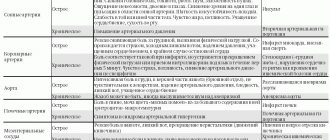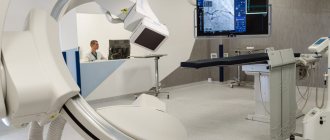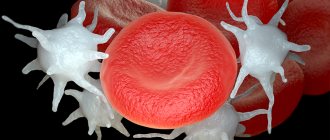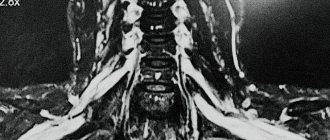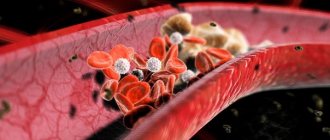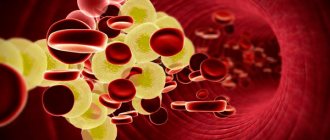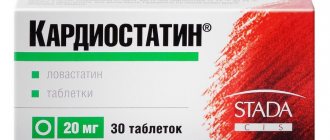1.General information
Atherosclerosis, arteriosclerosis, simply sclerosis and “damned sclerosis” are not the same thing, they are four different diagnoses. We jokingly and colloquially pose the last one to ourselves when we forget something or cannot remember; It most often has nothing to do with the actual state of health. In medicine, “sclerosis” is understood, in a broad sense, as thickening due to pathological, for one reason or another, proliferation of rigid and functionally useless connective tissue (synonym – fibrosis); in relation to hollow organs and especially vessels, sclerosis means thickening of the walls and, accordingly, narrowing of the lumen up to complete occlusion (obturation).
Arteriosclerosis (calcinosis) is calcification of vascular walls with calcium salts according to approximately the same scenario and with the same result.
Finally, the term “atherosclerosis,” which can be literally translated from Greek as “mush compaction,” means a sclerotic process caused by the deposition of one of the natural fatty alcohols, cholesterol (in some languages it is also called cholesterol) on the inner surface of blood vessels. Under and around such a cluster, the above-mentioned processes of fibrosis and calcification develop, as a result of which the lumen of the vessel and its throughput capacity progressively (at one rate or another) decrease.
Probably everyone has heard about atherosclerosis and cholesterol plaques in blood vessels. Many people try to adhere to cholesterol-free diets, and this certainly makes sense: in different parts of the world, a statistical connection between the frequency of atherosclerosis and the dominant “menu” in the region has long been confirmed. A direct consequence of vascular atherosclerosis is ischemia, i.e. insufficient blood supply to tissue and/or organ; The most famous and widespread (or rather, leading in statistics) example is coronary heart disease.
Atherosclerosis of cerebral vessels (cerebrosclerosis) is called the most common disease of the central nervous system. Most likely, this is the case, however, a direct correlation with age should be emphasized: the deficiency of cerebral vasculature (blood supply) caused by atherosclerosis is considered a chronic progressive endocrine-metabolic disorder, which must “have time” to form (and is usually formed in adulthood and old age) under the influence of a number of reasons and factors.
A must read! Help with treatment and hospitalization!
Diet for vascular atherosclerosis
First of all, it is supposed to reduce the consumption of fats (containing cholesterol) to such a level that they account for less than 30% of daily calories. In this case, the proportion of saturated fats should not exceed 10%. It is recommended that cholesterol intake be no more than 300 mg per day.
The next requirement for the diet is calorie restriction. In this case, the total caloric intake should not exceed 2500 calories per day. However, we must not forget about the variety and nutritional value of food. It is known, for example, that a deficiency of protein in food reduces resistance to stress, a lack of fatty acids contained in vegetable oils impairs brain function, etc.
Animal products
The consumption of saturated fat, or more simply cholesterol, can be reduced by reducing the amount of beef, pork and lamb. It is recommended to consume any meat products boiled.
It is necessary to remove the skin from the bird and avoid eating the internal organs of animals.
Fatty fish, such as halibut, contain a completely different type of fat that helps dissolve cholesterol plaques in arteries affected by atherosclerosis. Experts from Duke University believe that even one fish meal a week may be enough to reduce the risk of an unexpected heart attack by 50%. Interestingly, you can take fish oil instead of fish, which contains omega-3 fatty acids and lowers cholesterol.
Also, the diet should satisfy the body's needs for vitamin B6. It is actively involved in the processes of fat metabolism, in the transport and breakdown of cholesterol, and in organic iodine, which increases the synthesis of thyroid hormones. Thus, it stimulates the processing of dangerous cholesterol.
For this purpose, it is recommended to include seafood in the diet:
- seaweed dishes,
- squid,
- scallop,
- mussels, etc.
These are the products that lower cholesterol and “clean” blood vessels .
Products of plant origin
Vegetable oil contains “healthy” polyunsaturated fats. Olive oil is considered the most beneficial among vegetable fats. Try to replace them with other types of fats that contain bad cholesterol. Preference should be given to unrefined, cold-pressed olive oil. Because it contains a record amount of antioxidants that are beneficial for the heart and blood vessels, preventing the development of atherosclerosis. This oil is also involved in cleaning blood vessels from cholesterol.
But you can’t get carried away with vegetable oils either! This is often forgotten in recommendations. The fact is that an excess of polyunsaturated fatty acids can lead to a decrease in good cholesterol, which has an anti-sclerotic effect.
Cholesterol intake can be reduced by reducing the consumption of egg yolks (4 yolks per week) and organ meats:
- brain,
- kidneys,
- liver.
55-60% of daily calories should be provided by complex carbohydrates:
- vegetables,
- whole grain products,
- fresh fruits.
An important point is the inclusion of wholemeal products in the diet. The substances contained in the shells of grain crops bind and remove from the body cholesterol contained in food, as well as salts of heavy metals, nitrates and nitrites, carcinogens. Whole grain bread, wheat bran and oat bran contain coarse fiber. The norm is at least 20 g of fiber per day.
One of the richest sources of omega-3 fatty acids is flaxseed. Canadian cardiologists have found that regular consumption of flaxseed provides reliable protection against the formation of blood clots and cholesterol deposition in the arteries, leading to heart attack and stroke. The risk of heart attack can be reduced by up to 40%. 2 tbsp per day is enough. tablespoons of flaxseed, which can be added to porridge, salads and other dishes. Flaxseed should be stored in the refrigerator.
In fact, all of the above products can be classified as traditional methods of treating vascular atherosclerosis.
2. Reasons
To date, the etiopathogenetic mechanism of atherosclerosis continues to be the subject of intensive study and discussion. About ten main hypotheses are considered (viral, hereditary, chlamydia, autoimmune, etc.), each of which has the right to exist and finds well-reasoned confirmation. Perhaps atherosclerosis refers to the so-called. polyetiological, or multi-cause processes, or against the background of these conditions, is triggered by some common, not yet known trigger factor. However, risk factors have been quite reliably established that significantly increase this likelihood:
- - smoking and drinking alcohol;
- — physical inactivity combined with overeating and obesity;
- - arterial hypertension;
- - situations of chronic distress;
- - age-related hormonal changes;
- - diabetes;
- — certain metabolic disorders (metabolism), especially in relation to fats and proteins;
- - “viscosity” of blood (increased coagulability).
Visit our Cardiology page
3. Symptoms and diagnosis
The clinic of cerebrosclerosis, already developing pathomorphologically, can remain asymptomatic for a long time, then manifests itself with nonspecific and relatively mild symptoms, until, finally, with the development of ischemic changes in the brain tissue, it acquires its classic recognizable specificity.
Thus, tinnitus, “rolling” semi-fainting states and/or dizziness with a sudden change in body position, headaches, fatigue, decreased intellectual productivity are initially associated with completely different factors. Chronic overload, incl. emotional, previous acute respiratory viral infections and other diseases, vitamin deficiency, vegetative-vascular dystonia, etc. - can really cause such ailments. However, sooner or later cerebral ischemia manifests itself so-called. confusion or loss of consciousness, hemiparesis (partial and/or asymmetrical paralysis, numbness, loss of sensation in certain parts of the body), sudden and unexplained visual impairment. The composition and organization of speech, the ability to adapt, assimilate new information and solve various kinds of problems, fine coordination of movements, mental calculation, operational-mnestic functions (various modes of attention and memory), visual recognition - these and other components of the general intellectual level may decrease selectively and/or unevenly (depending on the predominant localization of the process), but inevitably lead to the formation of a psychoorganic syndrome or, as they say in psychiatry, vascular / atherosclerotic dementia. Emotional instability increases, signs of clearly inadequate perception, response and behavior appear. The most gentle and intelligent person can gradually become aggressive, brutal, literally unbearable in communication and dangerous in everyday life (a typical example is electrical appliances or gas left on “forgetfully” in the kitchen). From a certain point, such patients definitely need constant supervision and care, becoming practically helpless.
There are many possible options for the development and course of cerebrosclerosis, but this pathology has its own inexorable logic, and the most natural outcome is a fatal hemorrhagic (hemorrhage) or ischemic (necrosis, massive death of neurons) stroke.
To diagnose cerebral atherosclerosis, including in the early stages, the entire range of modern clinical, laboratory and instrumental methods is used: from a general examination, measurements of pulse and pressure in various zones, patho- and neuropsychological examinations - to biochemical blood tests and high-tech tomography and ultrasound examinations.
About our clinic Chistye Prudy metro station Medintercom page!
Consequences of atherosclerosis
Since atherosclerosis is based on a disorder of lipid (fat) metabolism in the body, leading to damage to the walls of blood vessels, the disease can contribute to partial or complete disruption of the functions of any organ. The consequences of atherosclerosis can pose a serious danger to human health and life. The main possible complications include the following.
Coronary heart disease. Atherosclerosis can lead to the development of heart rhythm disturbances, angina pectoris, myocardial infarction and sudden cardiac arrest, since the narrowing of the coronary vessels leads to the fact that the heart muscle does not receive enough oxygen, and the heart, compensating for its deficiency, strengthens its work.
Brain dysfunction. Without treatment, cerebral atherosclerosis can lead to deterioration of blood supply to the brain and, as a result, stroke, paralysis, systematic headaches, dizziness, visual and hearing disorders, swallowing and speech disorders, etc. Deterioration of blood circulation in the tissues of the eyes leads to a gradual decrease in visual acuity, which cannot be compensated. Therefore, it is important to pay timely attention to the treatment of cerebral atherosclerosis.
Thrombosis of the mesenteric arteries. Atherosclerosis can provoke acute blockage of the arteries that supply blood to the intestines, as evidenced by severe abdominal pain.
Shriveled kidney. Lack of oxygen in the tissues can lead to the gradual destruction of the kidney tissue, in its place connective scar tissue forms. The kidney decreases in size and partially loses its functions.
4.Treatment
Neuropsychiatric specialists deal with cerebral atherosclerosis. And if the question of complete healing and restoration of already lost functions is not raised today, then it is possible and necessary to significantly slow down the process by improving the somatic and psycho-emotional state of the patient. A special diet is prescribed; all self-destructive habits, of course, are completely excluded. An individual medication regimen is selected: anti-cholesterol, hypotensive, antiplatelet, vitamin-antioxidant, nootropic (all components according to indications), as well as certain types of massage, exercise therapy, herbal medicine. In some cases, vascular and neurosurgical interventions are indicated and successfully performed.
In conclusion, here is a saying from dark medical humor: the connection between atherosclerosis and old age is that both processes are incurable. But if with regard to old age it is indeed better to refrain from commenting, then regarding atherosclerosis we will still risk clarifying: it is irreversible YET, at the present time of the development of our knowledge, ideas and technologies. Let us remember: what kind of diseases were not considered incurable, including quite recently.
Treatment of multiple sclerosis
R
Multiple sclerosis (MS) is one of the most common diseases of the central nervous system (CNS).
In Russia alone there are more than 150 thousand such patients, most of whom are people of young working age. MS is an autoimmune disease, the main pathophysiological mechanism of which is autoaggression against myelin of the central nervous system
. However, as recent studies have shown, in MS, not only the sheaths of the CNS conductors, but also the axons themselves undergo morphological changes. It is axonal degeneration that causes the development of brain atrophy and irreversible neurological deficit, leading to disability in patients. Particularly important is the fact that axonal damage begins already at the initial stage of the disease, which dictates the need for early active therapy for MS.
Unfortunately, even today this disease remains incurable. But if previously therapeutic care for patients with MS was limited to attempts to stop exacerbations of the disease and provide symptomatic treatment, by now there have been ways to influence the course of the disease. This became possible thanks to the introduction of preventive (modifying) therapy into practice. The use of these drugs leads to a reduction in the number of exacerbations of the disease, makes them less pronounced and slows down the development of disability, which is the main goal of treating patients with MS. Thus, the modern approach to the treatment of MS consists of preventing exacerbations, stopping them and providing symptomatic therapy.
Preventive (modifying) therapy
Drugs that reduce the frequency of exacerbations of MS include b-interferons
and
Copaxone
.
The use of b-interferons, which have antiviral and immunomodulatory effects, in MS is based on the assumption of the role of persistent or latent viral infection in people with an altered immune system in the occurrence of this disease. b-interferons have a very wide spectrum of action, the main directions of which in the treatment of MS are the effect on viral replication and stimulation of the production of anti-inflammatory factors.
β-interferons used in the treatment of MS include betaferon, Avonex and Rebif. All these drugs significantly reduce the frequency of exacerbations in relapsing-remitting MS and slow down the increase in disability. Their use leads to a reduction in the number of hospitalizations and courses of hormonal therapy. The effectiveness of these drugs is estimated at approximately 30%.
The greatest experience has been accumulated in the treatment of PC with betaferon
. This is a recombinant b-interferon-1a produced by a culture of Escherichia coli. Betaferon not only reduces the number of exacerbations in relapsing-remitting MS, but also slows down the development of the disease in its secondary progressive form, occurring both with and without exacerbations. The drug is administered by patients independently, subcutaneously, at a dose of 8 million International Units (IU). In patients who do not respond to standard doses of betaferon, with a high degree of disability, a higher dose of 12 million IU may be prescribed.
Avonex
– human recombinant b-interferon-1a, produced by a mammalian cell culture. This drug has the advantage that it is administered once a week. It is used intramuscularly at a dose of 6 million IU.
Rebif
– also b-interferon-1a, administered subcutaneously, 3 times a week. It can be used in two dosages - 6 million ME and 12 million ME. The difference in the effectiveness of treatment with Rebif at different dosages is statistically insignificant.
When treated with b-interferons, the frequency of exacerbations decreases most significantly in the 2nd year of treatment, that is, the effectiveness of the drug accumulates over time. Prescription of Betaferon and Rebif is recommended for patients with disability up to 5.5 points on the EDSS (Expanded Disability Status Scale), Avonex - up to 4.0 points, but in any case the patient must be walking.
All b-interferons cause a fairly wide range of side effects, especially at the beginning of treatment. The most significant of them are local skin reactions (sometimes up to necrosis) and flu-like symptoms (fever, malaise, myalgia) - “interferon flu”. However, these phenomena disappear over time, and their occurrence can be prevented. Pain and skin reactions at the injection site can be reduced by following the rules for their administration (changing the areas of injection of the drug), wiping the area with a piece of ice before and after the injection. Skin reactions are less likely to occur if the drug is thoroughly dissolved and warmed to room temperature before administration. “Interferon flu” occurs at the beginning of treatment in most patients, but later it goes away in almost all of them, which is important to explain to the patient. In addition, these symptoms can be easily neutralized by administering the drug at night and taking paracetamol an hour before the injection or taking ibuprofen or pentoxifylline 2-3 times a day. In order to prevent the occurrence of side effects, it is also possible to reduce the dose by two times during the first administrations of the drug.
Other significant side effects of betaferon are that it increases spasticity and can cause depression. An increase in muscle tone is observed in those patients in whom it was quite pronounced before the start of therapy. If spasticity increases, the dose of muscle relaxants should be increased. The development of depression requires the prescription of antidepressants or even a break in treatment.
Avonex has fewer side effects. This may be explained by the fact that it is administered intramuscularly rather than subcutaneously. The skin is an active immune organ with immunocompetent cells that mediate humoral and cellular immune responses. Muscles are immunologically “quiet”.
Another preventive therapy drug, different in its mechanism of action from b-interferons, is Copaxone
.
This is the only drug to date that has an antigen-specific effect
. It consists of 4 amino acids - glutamine, lysine, alanine and tyrosine. The drug suppresses the cell-mediated response to one of the main autoantigens of the central nervous system - myelin basic protein. The interaction of T cells with Copaxone, instead of myelin basic protein, leads to the formation of suppressor Copaxone-specific T cells. These cells, penetrating the central nervous system, secrete anti-inflammatory factors that inhibit the development of the immune response leading to demyelination. The drug is administered daily, subcutaneously, at a dose of 20 mg; it causes only minor adverse reactions in the form of redness and thickening at the injection site, and a small number of patients experience systemic post-injection reactions in the form of general hyperemia, a feeling of tightness in the chest, shortness of breath, and palpitations. These phenomena go away on their own within a few minutes, without requiring medication correction.
To date, there is no experience of joint administration of b-interferons and Copaxone, but the safety and effectiveness of their use against the background of glucocorticoid therapy (in case of an exacerbation) has been proven.
The most important questions that arise when prescribing preventive therapy are: who should be given this treatment, when to start it and when to stop it, what is the indicator of ineffectiveness of this treatment?
Currently, there are undoubted indications for the use of modifying therapy
are reliable MS (see table), relapsing course of the disease (for betaferon also secondary progressive MS), patient age from 18 to 50 years, mild disability. Such treatment should be started as early as possible, since axonal damage, which subsequently leads to the development of an irreversible neurological defect, begins already at the initial stage of the disease. Treatment with these drugs should be stopped or replaced if side effects are intolerable or if treatment is ineffective. The lack of effect should be considered the need for 3 courses of glucocorticoid therapy over 1 year or a steady increase in disability over 6 months of treatment.
It is impossible to predict whether any of the preventive therapy drugs will have an effect on a given patient.
When prescribing these drugs, it is necessary to give the patient realistic prospects, warn about possible side effects, and teach injection techniques. Intravenous administration of immunoglobulin G has been proposed as an alternative immunomodulatory therapy.
. It also affects the frequency of exacerbations and the increase in disability. The drug is administered at a rate of 0.2-0.4 g/kg for 5 days, and then at the same dose once every 2 months. Other schemes for its use are also proposed - 1 g/kg monthly. However, the use of large doses of immunoglobulin is associated with an increased risk of cardiovascular and renal complications, as well as thromboembolism. In the first hours after the infusion, headache, myalgia, chills, and fever may occur. These phenomena can be stopped by reducing the rate of drug administration, using analgesics and antihistamines. Intravenous immunoglobulin has been successfully used in pregnant women with MS to prevent postpartum exacerbation.
Relief of exacerbations
Recently, treatment of severe exacerbations of MS with high doses of methylprednisolone
replaced the use of adrenocorticotropic hormone and its synthetic analogues.
Most exacerbations coincide in time with the formation of new active foci of demyelination, detected by MRI examination in the brain and spinal cord, which indicates a new wave of inflammation. The use of high doses of glucocorticoids accelerates their disappearance. However, after cessation of hormonal therapy, a new outbreak of disease activity may occur, which is also reflected in MRI findings. This may be due to the rate of hormone withdrawal, so the most optimal is to carry out “pulse therapy” with intravenous administration of methylprednisolone and subsequent transition to oral
prednisolone for several days: for 3-7 days, 1-2 g of methylprednisolone (the drug administered with 400-500 ml of saline solution for 1-2 hours), then oral prednisolone is prescribed - 4 days at 200 mg, 4 days at 100 mg, 2 days at 50 mg and then, reducing the dose every day by 10 mg . Other regimens for the use of prednisolone after intravenous administration of the hormone are also proposed - 2 days of 80 mg, 2 days of 60 mg, 2 days of 40 mg, followed by a daily dose reduction of 5-10 mg. This treatment is usually well tolerated. The drug is always prescribed at a time in the first half of the day. The most common side effects are insomnia and mild euphoria, anxiety, metallic taste in the mouth during infusion, increased appetite, nausea, gastrointestinal disorders, headaches, myalgia, hiccups. More serious complications occur less frequently - the development of psychosis, cardiac arrhythmias, hyperglycemia. This requires quick and qualified correction, so treatment with glucocorticoids must be carried out in an inpatient setting. To prevent the ulcerogenic effect of corticosteroids, H2-histamine receptor blockers should be prescribed simultaneously with them. To replenish the loss of potassium and calcium, asparkam, panangin are prescribed, and it is recommended to eat bananas. In addition, you should limit fluid intake and use potassium-sparing diuretics (spironolactone). Sometimes, after discontinuation of corticosteroids, there is a deterioration in the condition, in these cases it is necessary to re-prescribe 20-40 mg of prednisolone and again slowly reduce its dose.
Long-term use of small doses of steroids is not indicated, since a variety of known side effects are very likely to occur in the absence of significant effectiveness. Isolated (without intravenous administration) oral use of fairly high doses of prednisolone (1-1.5 mg/kg) gives short-term results, but, compared with intravenous pulse therapy, leads to greater disease activity in the future.
Hormonal pulse therapy not only stops exacerbations of MS, but also slows down the development of both relapsing-remitting and secondary progressive MS. Patients with this form of the disease can undergo this treatment 1-2 times a year or be administered every 2 months with 500 mg of methylprednisolone for 3 days. Intravenous hormonal pulse therapy is also indicated in the treatment of monosymptomatic manifestations of MS, in particular retrobulbar neuritis. The very common treatment with retrobulbar administration of dexamethasone is currently considered inappropriate by many researchers. One of the regimens for the treatment of retrobulbar neuritis may be as follows: intravenously for 3 days, 250 mg of methylprednisolone in physiological sodium chloride solution is administered intravenously every 6 hours, then oral prednisolone is prescribed for 10 days at a rate of 1 mg/kg and for subsequent 3 days quickly reduce this dose. If retrobulbar neuritis is accompanied by pain in the eyeball, nonsteroidal anti-inflammatory drugs may be prescribed.
In patients with acute, severe attacks of MS that do not respond to corticosteroid therapy, plasmapheresis
. It can also be combined with hormonal and other immunosuppressive therapies. When using this combination treatment for 2 weeks, 1.5 plasma volumes are exchanged up to 5 times per session; after the plasmapheresis procedure, 500-1000 mg of methylprednisolone with 400 ml of physiological sodium chloride solution is administered intravenously. A contraindication to the use of plasmapheresis is peptic ulcer disease. The most common side effects of plasma exchange transfusion are arterial hypotension and perioral paresthesia. Plasmapheresis is more effective for severe attacks of MS than for mild ones.
Despite the available data on the positive effect of some cytostatics on the course of MS (azathioprine, methotrexate, cyclophosphamide, cyclosporine A), it should be recognized that their use is justified only if hormonal and other immunomodulatory therapy is ineffective. With little therapeutic effect, these drugs cause a lot of side effects, and their use is strictly contraindicated in patients with a good prognosis.
During exacerbations, as well as in remission, “metabolic” therapy is prescribed, including nootropic drugs
(Cerebrolysin, piracetam, pyritinol),
lipotropic
(Essentiale),
vascular
(pentoxifylline, vinpocetine) and
vitamin preparations
(group B and tocopherol). The expediency of their use is determined by the need to maintain axonal function and prevent the development of axonopathy.
Symptomatic therapy
It is extremely important to carry out active, adequate symptomatic therapy in the period between exacerbations. For patients with primary progressive MS, it is often the only way to alleviate their condition. Currently, there are opportunities for real impact on the main manifestations of the disease.
For many patients with PC, general fatigue
, occurring in 75-92% of cases.
This symptom is often underestimated and is often mistaken for a “whim” or a manifestation of “neurosis.” Fatigue is not related to the degree of paresis; it is significantly worsened in the heat and when taking a hot bath. To correct it, it is very important to continue an active lifestyle and do dosed physical exercise
(excessive physical activity can aggravate this symptom).
The drug of choice for the treatment of fatigue is amantadine
.
In most cases, a sufficient dose is 100 mg per day. To increase the duration of its therapeutic effect, “vacations” are recommended for 1-2 days a week. If it is ineffective, you can use selegiline
, a dopaminergic drug, at a dose of 5 mg/day.
A common symptom of MS is intention and postural tremor.
.
Trembling can be very pronounced and occur even with the intention of movement, even before it begins, being the main disabling factor. Unfortunately, methods for correcting tremor in MS are ineffective. Isoniazid
has some positive effects , which has a greater effect on postural than on intentional tremor.
Isoniazid is used at a dose of 800-1200 mg/day in combination with 100 mg of pyridoxine (to prevent the development of polyneuropathy). Side effects of isoniazid include reversible liver dysfunction, drowsiness, fever, rash, nausea, and increased bronchial secretion. These phenomena can occur already with a dose of the drug of 600 mg and, given the less noticeable effect of isoniazid on tremors, they often force one to abandon its use. Hexamidine, carbamazepine, and clonazepam have a minor effect on tremor. Ondansetron
, which blocks central and peripheral 5HT3 receptors and is thus a serotonin antagonist, has also
been proposed for the treatment of tremors in MS Attempts at drug correction of tremors should be complemented by various rehabilitation methods - coordination exercises; with severe hand tremor, you can use fixing small weights of 400-600 g on the wrists. However, this can increase existing weakness and fatigue, and sometimes increase the tremor. In some cases, with severe tremors, stereotactic operations
- thalamatomy or stimulation of the ventral intermedial nucleus of the visual thalamus.
One of the most common and disabling symptoms of PC is increased muscle tone of the spastic type.
.
Spasticity can make movement even more difficult than weakness. Over time, increased tone in flexor muscle groups can lead to the formation of contractures. The basis for the treatment of spasticity should be exercise therapy, massage and physiotherapy
.
Pharmacological treatment only complements these methods and does not replace them. Before starting antispastic therapy, its possible consequences in the form of increased weakness must be assessed. The general rule for this treatment is to start with small doses and gradually increase them and use the minimum dose at which the desired effect is obtained. If a patient has painful muscle spasms at night, it is advisable to prescribe a muscle relaxant once at night. Baclofen
is most commonly used to reduce spasticity .
This drug is partially metabolized in the liver, so liver function should be checked before starting treatment and every 6 months. The initial dose of baclofen is 5 mg/day, the maximum is 100 mg/day. It is advisable to prescribe the initial dose (as well as increase it) at night to reduce side effects: drowsiness, fatigue, weakness, nausea, dizziness. It must be remembered that abrupt withdrawal of baclofen can provoke seizures. Another common agent for reducing spasticity is tizanidine
.
It is also metabolized in the liver, and therefore monitoring of its functions is necessary before starting therapy and then after 1, 3 and 6 months of treatment. The initial dose of tizanidine is 2-4 mg/day, it can be doubled every 3 days, but the total daily dose should not exceed 36 mg. The drug may cause dry mouth, drowsiness, and dizziness. Drowsiness occurs more often with tizanidine than with baclofen, but increased weakness, on the contrary, is less common. diazepam
in addition to these drugs .
Its initial dose is 2 mg/day, the maximum is 40 mg/day. Side effects of diazepam include drowsiness and cognitive impairment. Abrupt withdrawal can also cause epileptic seizures. For severe tonic spasms, botulinum toxin A
. The drug is injected directly into the spasming muscles. Paresis of these muscles begins to develop 24-72 hours after injection of the toxin, reaching a maximum on days 5-14, and lasts 12-16 weeks. When oral administration of muscle relaxants is ineffective, endolumbar administration of baclofen and surgical treatment methods are used to treat significant spasticity in immobilized patients: intersection of the tendons of the adductor muscles of the thighs, anterior and posterior roots of the spinal cord.
More than half of patients with MS at a certain stage in the development of the disease experience pain, varying in nature and intensity. Pain syndromes in PC
They can be acute (trigeminal neuralgia, tonic spasms), subacute (with retrobulbar neuritis, hemorrhagic cystitis) and chronic.
Half of all pain syndromes are chronic pain in the form of dysesthesia in the limbs and back pain. Dorsalgia is most often caused by impaired statics with the formation of a pathological posture. Treatment depends on the nature of the pain syndrome. An effective treatment for trigeminal neuralgia in MS, as well as idiopathic neuralgia, is carbamazepine
.
Other anticonvulsants also have a good effect - phenytoin, gabapentin and lamotrigine
.
Pain due to retrobulbar neuritis is well relieved by the use of analgesics, non-steroidal anti-inflammatory drugs and, if necessary, corticosteroids. For chronic burning neuropathic pain, the most common medications are tricyclic antidepressants and GABAergic drugs. Combination therapy
with clomipramine (10-25 mg/day), haloperidol (0.5-1.0 mg/day) and carbamazepine (100-200 mg/day) has a good effect on this kind of pain Back pain is well relieved by non-steroidal anti-inflammatory drugs. To correct pathological posture and strengthen paravertebral muscles, massage, physiotherapy, and exercise therapy can be useful. Benzodiazepines and anticonvulsants are used to relieve painful muscle spasms. Pain at injection sites when using beta-interferons is relieved by topical application of lidocaine, and diffuse muscle pain (“interferon flu”) is well controlled by non-steroidal anti-inflammatory drugs. Carbamazepine is effective for painful bladder spasms. Psychogenic pain responds to treatment with antidepressants. MS headaches, which most often have the character of tension headaches, are treated in the same way as headaches of this type in patients without MS.
Depression is a very common symptom of PC.
.
Apparently, depression in PC is multifactorial. It can be caused by a reaction to the disease, the disease itself, or side effects of the therapy. When treating depression, a combination of medication and psychotherapy is desirable. Amitriptyline
is most often prescribed (initial dose - 25 mg, therapeutic dose - 150-300 mg).
But other antidepressants are also effective in MS, as well as in depression of other origins, although their anticholinergic side effects (dry mucous membranes, impaired accommodation, headache, orthostatic hypotension, tachycardia) in this disease may occur at lower dosages. It should also be taken into account that manifestations of anticholinergic activity can aggravate urinary retention, blurred vision, and difficulty swallowing (due to dry mouth). Therefore, for the treatment of depression in patients with MS, it is recommended to use selective serotonin reuptake inhibitors that lack anticholinergic properties - trazadone
(initial dose - 50 mg, therapeutic - 150-600 mg),
sertraline
(initial dose - 25 mg, therapeutic - 50 mg),
fluoxetine
(initial and therapeutic doses - 20 mg),
paroxetine
(initial dose - 20 mg, therapeutic dose - 50 mg), etc. These drugs are effective and most often well tolerated. Treatment should begin with minimal initial doses, slowly increasing them after 3-5 days. It takes several weeks to achieve the desired result. If after 4-5 weeks there is no effect from treatment or after 6-8 weeks only a slight effect of the drug is observed, as well as in the event of difficult-to-tolerate side effects, it is necessary to change the drug. If the effect is good, therapy should be continued for up to 6 months, and then the patient’s condition should be re-evaluated to decide whether to discontinue the antidepressant or continue taking it.
For anxiety disorders, benzodiazepines can be prescribed for short-term use (diazepam - 2-10 mg/day, alprozalam - 3-4 mg/day, clonazepam - 4-6 mg/day, lorazepam - 3-4 mg/day). They are especially useful for a short period when informing a patient of the diagnosis of PC.
The course of MS is often accompanied by various paroxysmal syndromes
, which can be sensory, motor and mixed.
These include Lhermitte's symptom, Utgoff's symptom, paroxysmal itching, facial myokymia, tonic spasms, dysarthria, convergence spasm, etc. These paroxysmal symptoms are characterized by short duration (usually no more than 2 minutes) and high frequency - up to several hundred per day, and are often provoked by certain trigger factors - movement, stress, sensory stimuli, hyperventilation. All these paroxysmal disorders in most cases respond well to treatment even with small doses of carbamazepine
- 50-100 mg / day or
gabapentin
- 100-300 mg / day. If necessary, the dose can be increased until the desired result is achieved. Second-line drugs for the treatment of such disorders are phenytoin, phenobarbital, clonazepam, amitriptyline, etc. If such treatment is ineffective, hormonal pulse therapy is indicated.
The vast majority of patients with PC have urinary disorders
.
They are often the main cause of mood disorders, significantly reducing quality of life. From a clinical point of view, urinary disorders in patients with MS can be divided into difficulties with urinary retention and difficulties with emptying the bladder. There is often a combination of these disorders. Most patients with urinary problems can be helped conservatively. For imperative urination, the following are prescribed: tolterodine
(4 mg),
amitriptyline
(25-50 mg),
nifedipine
,
oxybutynin
(2.5-10 mg).
If there are difficulties emptying the bladder, an a-blocker is prescribed - terazosin
- 5-10 mg;
A side effect of this drug is the development of orthostatic hypotension. You can use drugs that reduce tension in the muscles of the external sphincter of the bladder - tizanidine
(8 mg),
diazepam
. If conservative therapy is ineffective, surgical treatment is indicated.
When complaining of constipation, you need to find out from the patient how often bowel movements occur and explain that daily bowel movements are not necessary. In most cases, to normalize intestinal activity, it is enough for patients to follow a certain diet and consume more fluid (which is not always possible in cases of simultaneous imperative urge to urinate) or take laxatives.
Following urinary disorders in PC, sexual disorders
. These disorders can be a consequence of damage to certain parts of the central nervous system, arise due to other manifestations of the disease (fatigue, spasticity, paresis), and also have a psychological basis. Sexual disorders in men are manifested by erectile dysfunction, ejaculation, and decreased libido. In women, they include the inability to achieve orgasm, insufficient lubrication and, less commonly, painful intercourse. Sexual disorders in women can also be associated with impaired sensitivity in the genital area, as well as high tone in the adductors of the hips.
Since sexual disorders in patients with PC may be psychogenic in nature, consultation with a sex therapist and psychologist is of great importance. You should also take into account what medications the patient is receiving, since many of them can affect sexual function. A side effect of Lioresal can be a decrease in libido, benzodiazepines - impaired ejaculation, tricyclic antidepressants - impaired erection and lubrication. Sildenafil has recently been increasingly used to treat sexual disorders in men.
.
Sildenafil is taken in a dose of 50-100 mg 1 hour before sexual intercourse. Side effects of this drug include headache, nasal congestion, facial flushing, and dyspepsia. Sildenafil is absolutely contraindicated in patients with cardiac pathology. It is possible to use devices for vacuum erection. Vasoactive drugs are also used: intraurethral suppositories with prostaglandin E1
and injections of this drug or papaverine into the penis. Side effects of this method may include pain at the injection site and fibrosis of the penis. It should be noted that although the initial effectiveness of this method is very high, after 2 years of its use it decreases significantly. The lack of lubrication in women can be compensated by the use of various intravaginal moisturizers, and a decrease in the orgasm threshold is achieved by the use of vibrators.
And, of course, at all stages of the disease, both in inpatient and outpatient settings, drug therapy should be supplemented with neurorehabilitation methods
– massage, physiotherapeutic procedures, exercise therapy and the use of various devices for the correction of movement disorders. Social assistance for PC patients is also extremely important.
The list of references can be found on the website https://www.rmj.ru
Tolterodine –
Detrusitol (trade name)
(Pharmacia)
Literature:
1. Gusev E.I., Demina T.L. et al., Immunomodulatory treatment of multiple sclerosis. Moscow, JSC Chertanovskaya Printing House, 1992.
2. Gusev E.I., Demina T.L., Boyko A.N., “Multiple sclerosis”, M., 1997.
3. Demina T.L., Gusev E.I. et al., The first experience of using the drug Copaxone in the treatment of relapsing-remitting forms of multiple sclerosis in Russia. Mater, to Region, owls. “Issues of diagnosis and treatment of demyelinating diseases of the nervous system”, M., 1999, pp. 127-129.
4. Demina T.L., Zavalishin I.A. and others. Aspects of pathogenetic therapy of multiple sclerosis. Mater, int. conf. “Improving the quality of life of disabled people with multiple sclerosis in European countries.” Samara, 1999, pp. 24-28.
5. Zavalishin I.A., Peresedova A.V., Zhuchenko T.D. From pathogenesis to treatment of multiple sclerosis. Mater, to Region, owls. “Issues of diagnosis and treatment of demyelinating diseases of the nervous system.” M., 1999, pp. 28-38.
6. Summer school on multiple sclerosis. Amsterdam, 1998
7. Multiple sclerosis. Selected Issues of Theory and Practice,” ed. I.A. Zavalishina, M., 2000.
8. Schmidt T.E., Zhuchenko T.D. Copaxone is a new drug for the treatment of multiple sclerosis. Bulletin of Practical Neurology, M., 1998, 4, pp. 15-18.
9. Schmidt T.E., Zhuchenko T.D., Lukyanova K.S. Prognostic value. differential diagnosis and treatment of retrobulbar neuritis in multiple sclerosis. Mater, to Region. owls “Issues of diagnosis and treatment of demyelinating diseases of the nervous system.” M., 1999, pp. 91-98. lO.Aisen ML et al. The effect of mechanical damping loads on disabling action tremor. Neurol., 1993,43,1346-1350.
11. Alam M. et al. Methylprednisolone in multiple sclerosis. A comparison of oral with intravenous therapy. J. Neurol. Neurosurg. Psych..1993,56,1219-1220.
12.Alter M. et al. Practice advisory on selection of patients with MS for treatment with betaseron. Neurology, 1994,44,15370-1540.
13.Barnes MP et al. Intravenous methylprednisolone for MS in relapse. J. Neurol..Neurosurg., Psych., 1985, 48, 157-159.
14.Bass V. et al. Tizanidine versus baclofen in the treatment of spasticity in patients with MS. Can.J.Neurol. Sci.,1988,15,15-19.
15.Beck RW Corticosteroid treatment of optic neuritis. A need to change treatment practices. Neurol., 1992, 42, 1133-1135.
16. Blaivas JG Management of bladder dysfunction in MS. Neurol., 1980, 30, 12-18.
17.Bozek S.V. et al. A controlled trial of isoniazide therapy for action tremor in MS. Neurol., 1987, 234, 36-39.
18.Canadian MS Research Group. A randomized controlled trial of amantadine in fatigue associated with MS. Can.J. Neurol.Sci.,1987,14,273-278. 19-Chezzi A. Sexual dysfunction in MS. Int.MSJ.5,2,45-53.
20. Fazecas F. et al. Intravenous immunoglobulin trials in MS. Int. MSJ, 6,1,15-21.
21.Fowler CJ et al. Treatment of lower urinary tract dysfunction in patients with MS. J. Neurol., Neurosurg., Psych., 1992, 55, 986-989.
22.Multiple sclerosis. Eds. Paty DW, Ebers GC, Philadelphia, 1997.
23.MS. Ed. Kesselring J., 1997.
24.Multiple Sclerosis Therapeutics. Eds. Rudick RA, Goodkin DE.2-nd ed., London, 2000.
25.Noth J. Trends in the pathophysiology and pharmacotherapy of spasticity. J. Neurol., 1991, 238, 131-139.
26.0sterman PO,Westerberg CE Paroxysmal attacks in MS. Brain.1975,38,189-202/
27. Polman Ch.H. Interferon beta Ib and secondary progressive MS. Int. MSJ,5.2,40-43.
28. Poser CM et al. New diagnostic criteria for MS. Guidelines for research protocol. Ann. Neurol., 1984, 13, 227-231.
29.Schapiro RT Symptom management in MS/Ann. Neurol., 1994, 36, 5123-5129.
30. Stenager E. et al. Sexual function in MS. 10' Congress of the European Committee for treatment and research in MS. Greece! 994/
31.Walter EU et al. Management of side-effects of beta-interferon therapy in MS. Int. MSJ.5,2,65-75.
32. Whitlock FA, Siskind MM Depression as a major symptom of MS. J. Neurol-.Neurosurg., Psych., 1980, 43, 861-865.
33. Weiner HL, Dawson DM Plasmopheresis in MS. Neurol., 1980, 30, 1029-1033.


